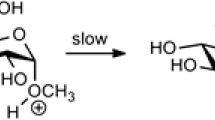Abstract
The determination of the degree of substitution (DS) of fatty acid cellulose esters with alkyl chain lengths from C8 to C18 was performed by direct transesterification with trimethylsulphonium hydroxide (TMSH) using tert-butyl methyl ether (MTBE) as a solvent. Transesterification was demonstrated to be quantitative at 75 °C in 60 min. The quantification of the formed fatty acid methyl esters was performed by gas chromatography (GC). After the optimization of the method, long chain cellulose esters (LCCE) could be analyzed in a wide range of DS. The obtained values were compared to those given by other existing protocols. LCCE with DS-values in a range of 5 × 10−5 to 3 were analyzed with high accuracy. Reproducibility is weakened for high DS values if the sample has a compact aspect limiting the accessibility of TMSH to the ester functions. This method can also be suitable for the analysis of mixed cellulose esters.







Similar content being viewed by others
References
Chauvelon G, Saulnier L et al (1999) Acidic activation of cellulose and its esterification by long-chain fatty acid. J Appl Polym Sci 74(8):1933–1940
Cunha AG, Freire CSR et al (2007) Bi-phobic cellulose fibers derivatives via surface trifluoropropanoylation. Langmuir 23(21):10801–10806
Deschamps G, Caruel H et al (2003) Oil removal from water by selective sorption on hydrophobic cotton fibers. 1. Study of sorption properties and comparison with other cotton fiber-based sorbents. Environ Sci Technol 37(5):1013–1015
Edgar KJ, Buchanan CM et al (2001) Advances in cellulose ester performance and application. Prog Polym Sci 26(9):1605–1688
Freire CSR, Silvestre AJD et al (2005) An efficient method for determination of the degree of substitution of cellulose esters of long chain aliphatic acids. Cellulose 12(5):449–458
Jandura P, Kokta BV et al (2000) Fibrous long-chain organic acid cellulose esters and their characterization by diffuse reflectance FTIR spectroscopy, solid-state CP/MAS C-13-NMR, and X-ray diffraction. J Appl Poly Sci 78(7):1354–1365
Magne M, El Kasmi S et al (2003) Method for treating lignocellulosic materials, in particular wood and material obtained by said method. Lapeyre. World Patent WO 084 723
Muller KD, Husmann H et al (1990) A new and rapid method for the assay of bacterial fatty acids using high resolution capillary gas chromatography and trimethylsulfonium hydroxide. Zentralbl Bakteriol 274(2):174–182
Peydecastaing J, Bras J et al (2006) NIR study of chemically modified cellulosic biopolymers. Mol Cryst and Liq Cryst 448:115–122
Peydecastaing J, Vaca-Garcia C et al (2008) Mixed acetic-fatty cellulose esters. Part II. Hydrophobicity. Cellulose (in review)
Samaranayake G, Glasser WG (1993) Cellulose derivatives with low DS.2. Analysis of alkanoates. Carbohydr Polym 22(2):79–86
Schulte E, Weber K (1989) Rapid preparation of fatty acid methyl esters from fats with trimethylsulfonium hydroxide or sodium methylate. Fett Wissenschaft Technologie 91(5):181–183
Sealey JE, Samaranayake G et al (1996) Novel cellulose derivatives.4. Preparation and thermal analysis of waxy esters of cellulose. J Polym Sci Part B-Polym Phys 34(9):1613–1620
Thiebaud S, Borredon ME (1995) Solvent-free wood esterification with fatty acid chlorides. Bioresour Technol 52(2):169–173
Tindall GW, Boyd BW et al (2002) Determination of acid substituents and unesterified hydroxyl groups in cellulose esters. J Chromatogr A 977(2):247–250
Tindall GW, Perry RL (1993) Determination of ester substituents in cellulose esters. J Chromatogr 633(1–2):227–233
Vaca-Garcia C, Borredon ME et al (2001) Determination of the degree of substitution (DS) of mixed cellulose esters by elemental analysis. Cellulose 8(3):225–231
Wang P, Tao BY (1994) Synthesis and characterization of long-chain fatty acid cellulose ester (FACE). J Appl Polym Sci 52(6):755–761
Wang P, Tao BY (1995) Synthesis of cellulose-fatty acid esters for use as biodegradable plastics. J Environ Polym Degrad 3(2):115–119
Acknowledgment
The authors thank LAPEYRE Company (France) for research funding.
Author information
Authors and Affiliations
Corresponding author
Rights and permissions
About this article
Cite this article
Peydecastaing, J., Vaca-Garcia, C. & Borredon, E. Accurate determination of the degree of substitution of long chain cellulose esters. Cellulose 16, 289–297 (2009). https://doi.org/10.1007/s10570-008-9267-8
Received:
Accepted:
Published:
Issue Date:
DOI: https://doi.org/10.1007/s10570-008-9267-8




